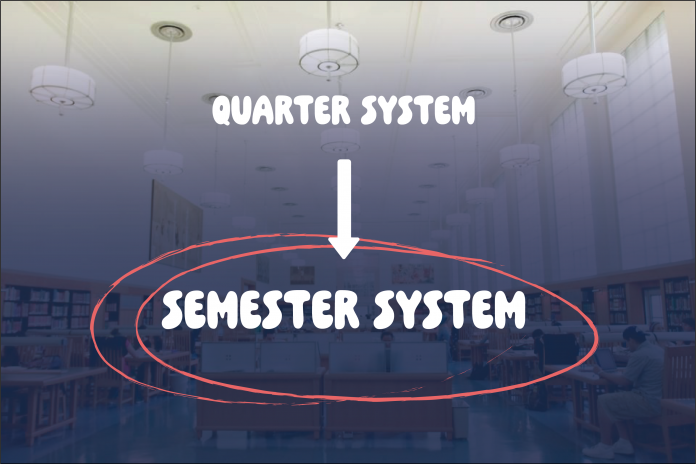Exploring the differences between semesters and quarters for college students
By ZOEY MORTAZAVI — features@theaggie.org
Across the United States, very few universities operate using the quarter system. Around 95% of the country’s colleges and universities implement the semester system instead, where students enroll in two 15-week sets of courses for the year. Under the quarter system, which we have here at UC Davis, students take courses across three 10-week quarters, with two optional summer sessions.
Many students appreciate the quarter system because of its shorter course lengths, allowance for more exploration of classes and frequent school breaks. Because nearby universities are choosing to make the switch to the semester system, students at Davis are beginning to weigh the pros and cons of the quarter system.
“The quarter system allows for a really deep dive into multiple subjects, which can be very beneficial for students looking to expand their academic horizons,” Alexander Liesegang, a first-year environmental policy analysis and planning major, said. “At the same time, if you struggle to grasp material for certain courses, it can make for a very stressful experience with no opportunity for a redemption arc. At the end of the day, I think the quarter system can be what you make it; sometimes I love it, other times I hate it.”
Most of the University of California (UC) schools utilize the quarter system — aside from UC Berkeley and UC Merced — and students tend to take the summer quarter off. At other universities, such as Dartmouth College in New Hampshire, students have a “flexivle study plan,” which grants them the freedom to choose which quarter they take off after their first two years as a full-time student.
Other universities, including Cal Poly San Luis Obispo (SLO) as of 2026, are beginning to make the switch from quarters to semesters. Cal Poly SLO, being the last California State University (CSU) on the quarter system, decided to make the switch to strengthen communication between the CSUs, as well as resolve other equity and articulation issues.
Many students seem to have mixed feelings about quarters. A common feeling from students is that they wish the quarter system allowed for further exploration into certain academic subjects, such as core classes for their majors. Students also report enjoying the ability to take a wider variety of courses.
“Honestly the quarter system is both good and bad, and mostly the latter. On one hand it allows me to cover more material, but at the same time I find myself wishing we had the time to discuss topics more in depth,” Daniel Blecman, a second-year history and German double major, said. “Oftentimes, many of the history courses I have taken have not gone through the entirety of the content, or barely touch upon concepts that I would love to go more in-depth to.”
Aside from the complaint about class depth, another issue some students at Davis have with the quarter system is its fast pace. With more difficult courses, some have a hard time keeping up with the workload, and the fast pace of 10-week quarters can make it difficult for students to catch up on work they may have missed.
“Though I appreciate the ability to take more unique classes in a school year, and thereby explore more subjects, I find it difficult to retain information at the quarter system’s fast pace,” Anthony Shepherd, a second-year international relations and Japanese double major, said.
Shepherd gave further context into how the quarter system works for his field of study.
“Language learning has been particularly challenging, since I spend the majority of time preparing for the numerous weekly vocabulary and ‘Kanji’ quizzes, that I find it hard to understand [or] recollect the nuances of the language introduced earlier in the course load,” Shepherd said. “Deeper into the major, it gets much harder to keep up with the dance of finding time to reinforce a hastily-built foundation while still adding more to the same demanding schedule.”
While there are definitely cons that students associate with the quarter system, many students still enjoy it and argue that it works well for them. Overall, it seems to depend on how individual students are wired, and what kind of system is most productive for their habits.
“In my opinion, the quarter system is a system that really works, although it’s a negative that we sometimes have to really rush to get things done,” Hazel Henninger, first-year history major, said. “Overall, I feel like it’s a really efficient use of time for students to get credits out of the way more quickly. I also like that the quarter system allows us to explore new opportunities, inside and outside of class.”
There are theories circulating that the UCs will join the CSUs and eventually make the switch to semesters. However, no official statements have been made implying that they are planning to make this change. UC San Diego considered altering the duration of their courses from 10 to 15 weeks, which was reported back in 2020, but no changes have been made since that time.
Until the UC system makes the decision to switch its universities to semesters instead of quarters, it appears that they are here to stay. UC Davis students report mixed feelings regarding the quarter system but say that it can be precisely what you make of it. Whether or not you like the 10-week course system, learning to adapt to new circumstances and adjust your study and work strategies can make a world of difference for students.
Written by: Zoey Mortazavi — features@theaggie.org





